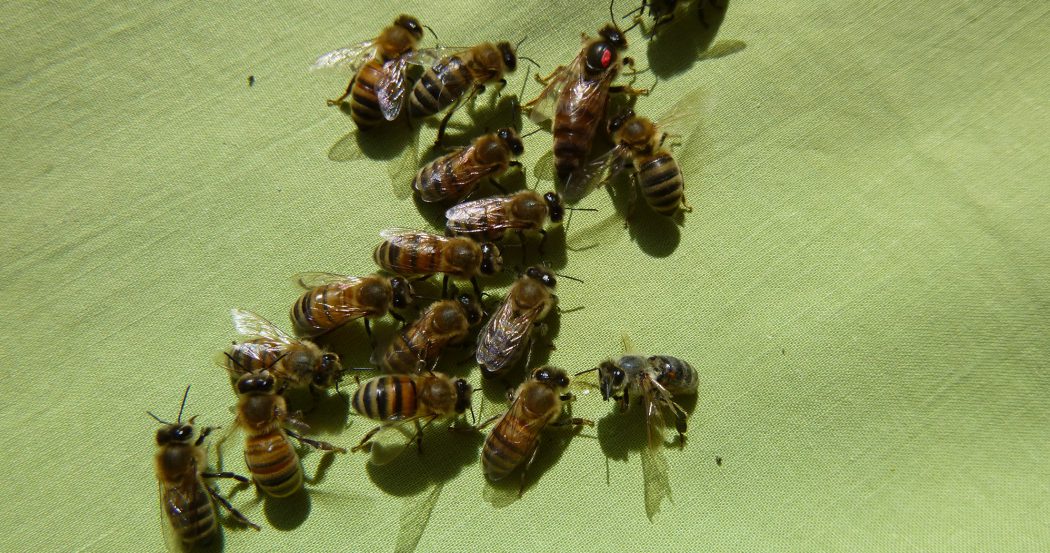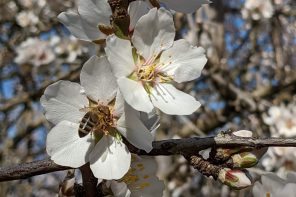By: Tina Sebestyen
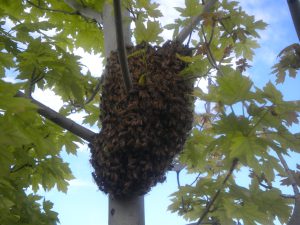 It might be tempting to think that it is all right not to worry about whether colonies are going to swarm, since swarming is a natural thing that honey bees do. In fact, we know that our colonies need to swarm to help keep mite numbers low, besides the need to keep colony numbers up. They are, in a way, working to replace colony losses before they occur, in the same way we humans do. Many urban backyard beekeepers are happy with their two colonies, and don’t want more, so they would rather let the swarm hit the trees than split and deal with excess colonies. There is also the hard fact that splitting intimidates newer beekeepers. There are some significant negatives to this strategy, however.
It might be tempting to think that it is all right not to worry about whether colonies are going to swarm, since swarming is a natural thing that honey bees do. In fact, we know that our colonies need to swarm to help keep mite numbers low, besides the need to keep colony numbers up. They are, in a way, working to replace colony losses before they occur, in the same way we humans do. Many urban backyard beekeepers are happy with their two colonies, and don’t want more, so they would rather let the swarm hit the trees than split and deal with excess colonies. There is also the hard fact that splitting intimidates newer beekeepers. There are some significant negatives to this strategy, however.
For one, when a swarm leaves a colony, it will usually find a home within flight range of the parent colony. The bees and mites increase in number until Fall, when, without your help with Integrated Pest Management or treatment, it collapses, your bees rob the failing colony and bring the mite load home, and they die, too. You have seeded your very own mite bomb. Or maybe, your bees are the perfect, mite resistant bees, so you don’t have to worry about that. They just move into your neighbor’s attic, it costs him $350 to have them removed, and you and your bees have earned an enemy. Or maybe, the swarming bees only take your honey production and pollination work force with them. Allowing colonies to swarm isn’t a very good way to help honey bee numbers overall, since only 8% to 24% of swarms survive the first Winter(1). The bottom line: it is important to control swarming.
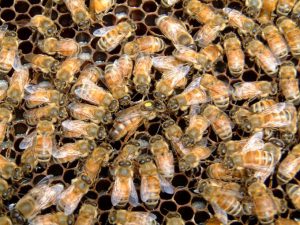
The queen with her retinue. As they feed and touch her, they pick up her pheromones and pass them throughout the colony. Amazingly, all 60,000 bees know she is gone with 15 minutes, usually, and will begin keening for her.
Photo credit: Tina Sebestyen
The good news is that if you want to have all the benefits of a swarm, without any of the disadvantages, there are ways to control it. The best, for sure way to control swarming is splitting. Even a simple split; three frames of brood, and one of food, with the bees that are on them with the old queen is probably the best. This mimics a swarm, the old queen leaves the colony with some of the bees (but this way, far fewer than would have gone in a natural swarm). You can sell the nuc that you have just created so that you don’t end up with extra bees, and help provide local bees for your area. But still, people sometimes don’t want to make even this simple split (usually because they can’t find their queen, we’ll solve that problem later in this article). There are other ways to control swarming without splitting, though some of them may be more work than the split would have been.
One of the reasons that swarms happen when they do is that the queen’s pheromones (QMP) are not very volatile, meaning they aren’t spread in the air so much. Rather, they are spread by touch. The bees in the queen’s retinue pick up the chemicals from her (her pheromones) as they feed her, antennaete her, touch her with their feet and lick her, and they then pass these chemicals from one bee to the next, so that all of the bees in the colony know that the queen is present. As the queen ages, her pheromones become weaker, and as they are spread throughout the colony, everyone gets a smaller portion. The crowded conditions in a Springtime colony mean that the pheromones get spread even further, and this triggers the swarming instinct in the bees. Young queens have much greater amounts of QMP, and this helps keep the colony from wanting to swarm. So, replacing the old queen (one that has been through even one previous Spring build-up) with a young, well-mated queen can help control the swarm tendency. Re-queening alone will not be enough, even a young queen will swarm when the brood nest is congested. It is definitely important to ensure that there is a lot of space for the queen to lay eggs. Making sure that there is someplace else to store honey is critical. Supers must be added before nest congestion even begins.
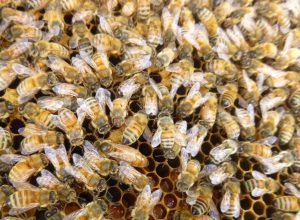
The queen pushes through bees on the comb while leaving a wake behind her. This works best when the comb is solid with bees, and there are fewer random spaces on the comb. Photo credit: Tina Sebestyen
Controlling swarming is more work with an older queen. It may be necessary to remove most or all of the brood from the area the queen can access. One way to do this is just to confine the queen to a box of only frames with foundation and two frames of emerging brood, using a queen excluder. It will take time for the bees to draw comb for the queen to lay eggs in, thus creating a small brood break. Full honey supers function very effectively to limit movement of bees, thus creating the same conditions that would be felt after a swarm had already occurred. Emerging brood can be moved to the top of the stack (or behind the other bars or frames in horizontal beekeeping). Once the young bees emerge, the comb is ready for honey. Separating the queen from capped brood is a very effective swarm control strategy.
Or, frames of open brood can be moved up, and they will attract many of the nurse bees, thus relieving crowding around the queen (this is called the Demaree method)(2). The separation of open brood from the queen and the distance created by the full honey supers causes nurse bees to start queen cells. These must be killed or moved to mating nucs, and the now-capped brood in the upper chamber moved down while eggs and young larvae from the queen’s box must be moved up after seven to nine days. It may be necessary to do this rotation twice during the honey flow to keep the swarm instinct under control. Another idea is to leave one queen cell in the upper box, which should have an exit facing in a different direction than the main entrance below. The virgin queen will hopefully mate and return to the upper hive body, and now you have a very, very efficient honey producing colony with two queens and a huge work force. After the main honey flow, the old queen can be culled, leaving the young new queen to head the colony.
Re-queening a colony in July is a very effective way to ensure that when Spring arrives, swarm control will be simpler, since this queen has never been through a Spring build up and has good, strong pheromones. Two other benefits to mid-Summer re-queening are greater numbers of fat Winter bees and a good brood break for mite reduction. Colonies with young queens raise 3,000 more fat Winter bees than colonies headed by older queens(3). These bees are better able to survive Winter, produce heat, conserve honey use and feed brood in early Spring. And since the brood break created while the colony raises a new queen in mid-Summer means that all of the brood has emerged, the brood break can be combined with an oxalic acid mite treatment. This is a most effective heat-of-Summer mite reduction when many other treatments cannot be used due to temperature thresholds. When the young queen begins laying eggs (do the math so that this is early enough to raise two brood cycles, or 42 days before it freezes), mite counts will be low, and you have protected your fat Winter bees from them and the diseases they carry.
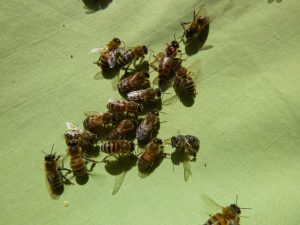
No queen excluder? Just shake the bees in front of the hive on a pillowcase (not a towel, it catches their feet) and as they spread out and walk in, you can catch your queen. Photo credit: Tina Sebestyen
You may have noticed that all of these strategies for reducing or attempting to manage the swarming instinct require movement of or removal of the queen. The main reason people don’t want to do splits in the first place is because they don’t know how to find the queen. Admittedly, even seasoned beekeepers may find it a challenge to locate a queen in a super-full, swarm-ready colony. Because this is a skill that should be honed, let’s start out by looking for her.
Tricks to help in finding the queen
First, if you want to find the queen, you want her to continue doing what she was doing, which means not smoking the colony before opening it up. In Spring, the bees are happy and non-defensive, so smoke is probably not needed anyway, unless it is a very defensive colony, in which case it is even more important to find that old queen! If you must smoke, then do it, but try to find her without smoking, if possible. Remove the honey supers and set them aside after you have ascertained that there is no brood in them.
As you expose the top of each brood box, look at the bees on the tops of the frames. If it is the box with the queen in it, there will be a five inch circle where the bees are more concentrated than elsewhere. The queen is under this circle of bees. Remove the outer frame to create room to work, then push all of the frames at once away from the one you suspect may contain the queen. Working quickly will help in finding the queen, since the light coming in will make her want to run. Remove the frame that was in the center of the circle of bees, and, rather than looking for the queen, look at the whole frame. Hold it at arm’s length and let your eyes take a snapshot of its entirety. You are looking at the pattern of bees on the frame. There will be bees facing in every direction and going about their business. But, if the queen is stationary, her retinue will be in a circle around her, caring for her. If she is in motion (which she probably will be) she must push her way through the crowds of bees, but behind her there will be a bare space on the comb, a wake like would be behind a boat on an algae-covered pond. This works best in a super-full colony, just what we have in Spring.
Once you see either a circle of bees, or a bare spot on the comb, now look for the queen. Her big, bald thorax is a good clue. Of course, drones have big thoraxes, too, but they are usually still fuzzy. The queen’s is bare because as she measures each cell to know if it is for a drone or for a worker, she rubs the back of her thorax, and that makes it bald(4). Now that you have found her, you need to be ready to capture her. Lay your hive tool on the tops of the frames to act as a stand for the frame, and set the top bar of the frame on the hive tool, this frees up your two hands, and helps keep the frame from crushing the bees on the backside of it.
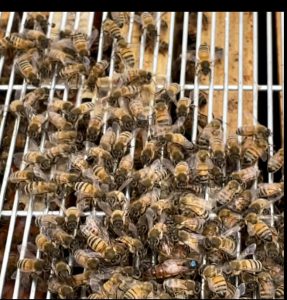
Using a queen excluder to find the queen is fairly fool-proof, if you are careful to shake every comb and every box as you go. Keep in mind, if you don’t find the queen this way, there may not bee one present (the colony may have swarmed already and there is a virgin in the hive, who may be able to cross an excluder). If you find recently emerged queen cells, don’t be looking for the queen! It is much too disruptive, and you may cause the bees to kill their own, brand new queen if you go looking for her less than two weeks after she emerges.
Photo credit: Tina Sebestyen
A queen catcher is a nice thing to have, and I keep one in my pocket at all times. Even better, in this situation, is to pick up the queen with your fingers and put her in a queen cage, then hold your index finger over the hole. Once you get her inside, look at the frame you just set down and find a bee with just its butt peeking out of a cell. This is a nurse bee who is feeding larvae, and she will be able to feed your queen, too. When she backs out of the cell, pick her up by her wings and put her in the cage with the queen. Find four or five of these young nurse bees, and put them all in with the queen. If you don’t have the patience to carefully choose nurse bees this way, at least pick young, fuzzy bees, but not newly emerged ones. They need to be at least five days old to have developed hypo-pharyngeal glands for royal jelly production.
Now, you can do whatever you like with this queen. I almost never pinch a queen, unless there is something major wrong with her. Placing her in a cage with four or five nurse bees gives you a week to decide what to do with her. It might be nice to make a small nuc to support her. If your colony will be making their own new queen, there is a 20% chance that she won’t make it back from her mating flight, so it is nice to have the old one in the bank. If you have bought a queen for replacement, there is still the chance you’ll need this old one, or you can sell her to someone who is desperate and is dealing with a less-than-ideal situation (no brood, laying workers, etc.)
The other way to find a queen, and what you can do if you look for yours and can’t find her, is to employ a queen excluder. Since queens can’t normally cross through a queen excluder, it is possible to find her using one.
First, set all of the boxes aside, away from the bottom board, and a few feet from one another. In just a few minutes, the boxes that do not have the queen will begin keening for her. It is a sound like no other in beekeeping, and once you hear it, you’ll always know what it means. The box that is quiet is the one with the queen (the bees can be a little tricky about this, it is a clue to her location, not a fact).
Set a new hive body on the bottom board, or take all of the frames out of a box and set them carefully where they will be safe. Shake the bees off of the side walls into another box and set the empty one on the bottom board, with the queen excluder atop it. Now, take each frame and shake the bees off of it, over the queen excluder. The worker bees will begin passing through, leaving the queen behind for you to capture. If the bees don’t want to go down, you can push them down with a little smoke. Once enough of the bees have passed through to see that the queen was not on that frame, lift the excluder a bit and put the frame into the box. Pick up the next frame, shake it, look for the queen, place the frame in the box. Continue until the queen shows up on the excluder, remembering to shake the bees off of the side walls of hive bodies, and even out of the honey supers until she is found. This method takes no particular skill, nothing but time and patience. You do need to be able to handle the queen once you’ve found her, so practice on drones until you get really good at catching them by their thorax alone, without touching their abdomens. Go ahead and mark them while you’ve got them, for practice. Practice makes perfect, just like our moms said, and beekeeper experience is a leading indicator of colony survival.
Rangel, J., Seeley, T.D. Colony fissioning in honey bees: size and significance of the swarm fraction. Insect. Soc. 59, 453–462 (2012). https://doi.org/10.1007/s00040-012-0239-5
Caron, Dewey and Connor, Lawrence, Honey Bee Biology and Beekeeping, 3rd Edition, pg. 281, (2022) Wicwas Press
J. Lloyd Harris (2008) Effect of requeening on Fall populations of honey bees on the northern Great Plains of North America, Journal of Apicultural Research, 47:4, 271-280, DOI:10.1080/00218839.2008.11101474
Kearney, Hilary QueenSpotting, Meet the Remarkable Queen Bee and Discover the Drama at the Heart of the Hive (2019). Storey Publishing






